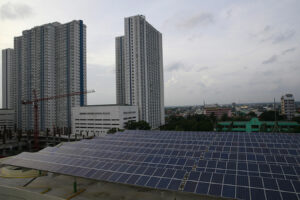By Kyle Aristophere T. Atienza, Reporter
SINGAPORE — The Philippines saw a 57% increase in “green” investments to $1.46 billion in 2023, but still falls short of the over $16 billion in required capital investments needed for its green transition, a report showed.
Private green investments in the Philippines accounted for nearly a fourth of the $6.3 billion in total green investments in Southeast Asia last year, according to the 2024 Green Economy Report for Southeast Asia.
“However, an investment gap exists, and significant efforts must be made to meet the required capital investment of $16.6 billion,” it said, noting that the Philippines could achieve this by boosting blended finance, improving renewable regulations and strengthening regional collaboration.
The report by Bain & Company, GenZero, Standard Chartered and Temasek was launched at the 2024 Ecosperity forum, which gathered leaders across the world to track developments in the global green economy.
The Philippines’ score in Bain & Company’s 2024 Green Economy Index increased by three points to 39 from the previous year. The report said the Philippines’ “upward trajectory” was driven by progress within corporates’ ambitions and roadmaps.
Vietnam recorded the biggest improvement — up by five points to 38 — but it still lagged behind the Philippines along with Cambodia (38), which saw a three-point increase.
Singapore had the highest score at 55, up by four points from the previous year. It was followed by Malaysia (43), Indonesia (41) and Thailand (39).
Laos and Myanmar got a score of 30 and 27, respectively. Brunei got 8.
The region is “woefully off-track” on green investments, said Kimberly Tan, GenZero’s managing director.
Green investments in Southeast Asia jumped by 21% to $6.3 billion last year, mainly due to renewable energy projects and “green” data centers. Malaysia and Laos saw a 326% and 126% surge, respectively, in green investments.
However, Southeast Asia is still facing a $1.5-trillion investment gap until 2030 to fund its green transition. Clean energy accounts for only 10% of power supplies in the region, with fossil fuel subsidies being about five times higher than renewable investments, according to the report.
“Despite Southeast Asia’s structural challenges, immense potential exists to accelerate the energy transition and build the green economy,” Dale Hardcastle, director of the Global Sustainability Innovation Center at Bain & Company, said in a statement. “Focusing on proven solutions to decarbonize and accelerators such as blended finance or other incentives can catalyze investment, while governments need to figure out the more complex changes.”
The Philippines lacks sector-specific emission targets, and only four of 10 major emitting companies have set net-zero and emissions goals, according to the report.
However, it said domestic investments in infrastructure for green energy are “brisk.”
Philippine renewable energy investments have risen after it allowed full foreign ownership in the sector starting November 2022. It also established special lanes to expedite such projects.
The report said the Philippines should build more solar projects through blended finance, establish a clear framework to enforce renewable portfolio standards and develop a comprehensive energy roadmap to give investors predictability.
“It is an exciting time in the Philippines, with generational changes happening in digital payments, infrastructure and climate transition,” Mike Samson, chief executive officer at Standard Chartered Bank Philippines, said in a statement. “The Philippines is on the cusp of significant growth.”
Mr. Samson said the Philippines should work with its Southeast Asian neighbors on technological transfer and co-innovation of clean technologies; cross-border investments in “greenification” of manufacturing and nickel processing; and shared agreements on key standards.
DEFORESTATIONMeanwhile, the report cited “further deforestation” in the Philippines due to continued commodity-driven forest loss from mining, forestry and other urbanization activities.
Environment Secretary Antonia Yulo-Loyzaga said in a panel discussion after the launch of the green economy report that “there are great opportunities” in the Philippines for “reforestation, afforestation and for carbon sequestration.”
The Philippines has 30 million hectares of land, 15 million of which are classified as forests.
She said the Department of Finance is working with the World Bank and the ADB to finalize a policy framework for emission trading schemes and a possible carbon tax.
“We are looking at bilateral as well as multilateral consultations,” Ms. Loyzaga said.
The report noted only Indonesia, Malaysia, Singapore and Vietnam have been able to put a price on carbon.
Several Philippine agencies such as the Justice and Energy departments and a presidential investments office were also looking for another possible offshore gas field, she said.
The Malampaya gas field, the country’s sole indigenous source of natural gas that accounts for at least 40% of electricity needs in the capital region, is projected to run dry by 2027.
Philippine agencies were also updating guidelines for offshore wind and floating solar projects, Ms. Loyzaga said.
